M&RIE Receiver Preferred for Sound Quality and Localisaton
Advertorial
ABSTRACT
Each of us has been listening to sound shaped by our unique pinnae, head and torso throughout life. This personal filtering of sound is a large determinant of what creates a sensation of naturalness, transparency, and immersion in the acoustic environment. Along with interaural level and time differences, the spectral cues provided by our individual anatomy and enhanced by the way we move our heads and bodies help us to orient to our environment and locate and separate sounds from each other. This allows us to focus on the sounds we want to hear, tone down those we don’t, and feel connected to our surroundings. In essence, everyone hears differently.
Introduction
Receiver-in-the-ear (RIE) hearing aids are the most popular style of hearing aid today. Unfortunately, the location of the microphones on the devices deprives users of natural cues for spatial hearing. ReSound ONE preserves these cues with the M&RIE receiver module. It places a microphone in the user’s ear canal along with the receiver and allows sound to be collected in the most natural location. This article presents the results of two experiments that explored sound quality preferences and localisaton performance with the M&RIE and traditional RIE microphone location, as well as pinna compensation algorithms using the RIE onboard microphones.
The ReSound Organic Hearing philosophy inspires us to develop solutions that enable people with hearing loss to connect to the world in the most intuitive and natural way. With the ReSound ONE™, we introduce a breakthrough that combines the benefits of the popular Receiver-in- the-Ear (RIE) style of hearing aid with the advantages of collecting sound as nature intended: in the ear canal. The M&RIE receiver module includes a microphone that is placed within the ear canal, thereby preserving the natural and individual shaping of sound by each person’s unique anatomy. As a supplement to the onboard microphones on the RIE device, the in-ear microphone of the M&RIE provides the user with natural, immersive sound quality during the many hours most people wear their hearing aids in relatively quiet conditions. In more complex listening environments, the intelligent steering of All Access Directionality seamlessly activates the device microphones, enabling the directional processing that helps them hear better in noise.
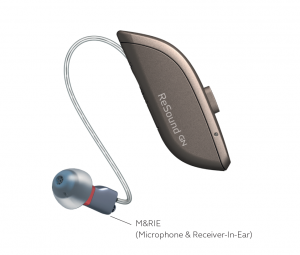
The most personalized hearing in a RIE
RIE hearing aids owe their popularity in part to the fact that the receiver is placed in the user’s ear canal rather than in the device. This gives advantages over a behind- the-ear (BTE) hearing aid cosmetically because RIEs can be made smaller and are fit with a barely visible wire connecting the device to the receiver. There are also practical and acoustic advantages, as the RIE power level is determined by the external receiver selected by the fitter, and the location of the receiver in the ear canal eliminates tubing resonances that can be a fitting challenge with the BTE style. However, both the BTE and RIE share the dis- advantage of placing the microphones in the body of the hearing aid which sits above and behind the pinna. This unnatural microphone placement removes the influence of the hearing aid user’s unique pinna on the sound heard by the user. A mitigation to this issue can be achieved by using the hearing aid’s two microphones to create a similar directional response to the average open ear for sound on the horizontal plane. This type of processing is offered by most hearing aid brands. These features are commonly referred to as “pinna compensation”, “pinna restoration” or “digital pinna” algorithms.1 While helpful, pinna compensation algorithms are unable to shape sound in precisely the way the hearing aid user’s personal, unique pinnae would do.
Until now, only in-the-ear (ITE) hearing aids, with their microphones placed within the pinna, have been able to preserve the spatial cues of the hearing aid user’s unique pinnae, head, and torso. ReSound ONE with the M&RIE changes all that. It is the only RIE that gives users the personalized benefits of in-ear microphone location and unique advantages of the RIE style such as All Access Directionality.5
Product development research using simulations and prototypes of the ReSound ONE and M&RIE suggested substantial benefit of this approach in terms of localisaton and sound quality.2 It is also of great interest to investigate whether these positive results hold up to further scrutiny in the finished product. Therefore, two experiments were carried out to validate the sound quality and sound localisaton benefits of M&RIE and ReSound ONE. In the first experiment, listeners judged sound quality with M&RIE compared to an omnidirectional response using the front device microphone as well as the ReSound proprietary 2-microphone pinna compensation algorithm. The second experiment tested listeners’ ability to localize with M&RIE compared to an omnidirectional response using the front device microphone, the proprietary 2-microphone pinna compensation algorithm and other brands’ RIEs in their default programs including their pinna compensation algorithms. It is established that people with hearing loss perform worse than people with normal hearing on localisaton tasks. It follows that they may also be less sensitive to nuances in sound quality. In addition, amplification for hearing loss compensation may obscure the acoustic effects of microphone location on a hearing aid. Therefore, both experiments included listeners with normal hearing to illustrate the potential benefit of the M&RIE solution, as well as listeners with hearing loss to illustrate typical benefit and the range of benefit for actual users.
EXPERIMENT 1:SOUND QUALITY PREFERENCE
Methods
Participants
Ten normal-hearing listeners with thresholds better than 15 dB HL4 and ten listeners with bilateral mild-to-moderately sloping sensorineural hearing loss participated in Experiment 1. The median age was 39 years (1st quartile: 34 years and 3rd quartile: 42 years) for the normal-hearing listeners and 59 years (1st quartile: 53 years and 3rd quartile: 66 years) for the listeners with hearing loss. The listeners with hearing loss included participants who were inexperienced with amplification as well as participants who were not. The listeners with hearing aid experience were users of premium RIE hearing aids. The median years of experience with amplification was 3 years (1st quartile: less than 1 year and 3rd quartile: 4 years).
Hearing aids and fitting
ReSound ONE RIE hearing aids were used for the sound quality experiment. For the normal-hearing listeners, the hearing aids were fitted with 10 dB of flat, linear gain. For the listeners with hearing loss, the hearing aids were fitted with gain prescribed according to their audiograms by the ReSound proprietary Audiogram+ fitting rationale. The hearing aids were fitted with omnidirectional processing in one program, Spatial Sense (which includes 2-micro- phone pinna compensation and binaural compression3) in another program and M&RIE in a third program. Feedback management was active in all programs. Other advanced features were turned off.
Test conditions, methodology, material, and setup
The sound quality preference experiment included three conditions: M&RIE, Spatial Sense and omnidirectional. The three conditions were programmed into three programs in a pair of ReSound ONE hearing aids fitted as described above.
ReSound and other hearing aid manufacturers have often carried out sound quality experiments by making recordings on an acoustic manikin and having listeners evaluate the conditions under headphones.6-7 This allows double-blinding and eliminates multiple other sources of bias. However, the present test was conducted live, with the hearing aids on the listeners’ ears, to ensure that the listeners benefitted from their individual natural pinna cues as preserved by M&RIE. Therefore, sound quality comparisons are only made for different configurations of the ReSound ONE hearing aids to avoid having to switch out the hearing aids between trials.
The sound quality preference experiment was conducted using a paired comparison methodology. The task of the listeners was to listen to the hearing aid programs in pairs, by switching back and forth between programs and choosing which program of each pair they preferred. The ReSound Smart 3D app was provided to the listeners on an iPhone so that they could use it to quickly switch back and forth between programs, enabling them to perform the paired comparison listening test within the auditory memory time span of 2-4 seconds.8-10 Program change beeps were turned off to make switching programs more seamless. The listeners provided their program preference on paper.
Paired comparisons were made for the three programs, but the listeners did not know which settings were in each program. The testing order of the conditions, M&RIE versus omnidirectional, and Spatial Sense versus M&RIE, was counterbalanced across listeners.
The listeners repeated the paired comparisons while listening to multiple sound scenarios. A description of the sound scenarios is shown in Table 1. The sound scenarios were selected to be representative of different hearing aid user environments. The testing order of the sound scenarios was randomized for each listener using a Latin square design.
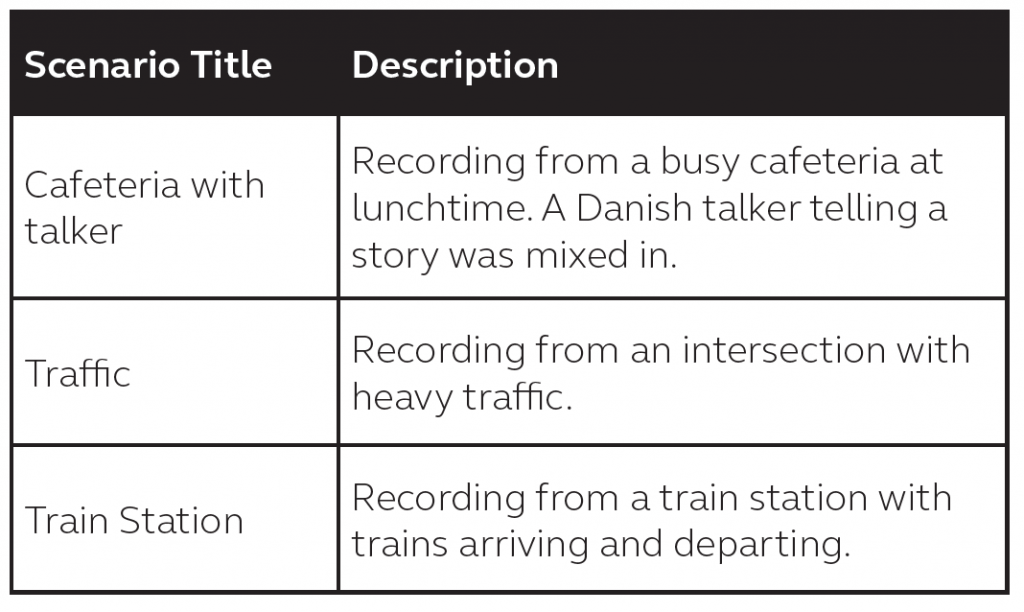
The sound scenarios were recorded with a 32-channel microphone array, an Eigenmike, from MH Acoustics. They were played back over an array of 39 loudspeakers, using the 4th order Ambisonics recording and playback system. This allows for realistic reproduction of the sound environments in which spatial sound information, as present in the original environments in which the recordings were made, is preserved. This is important when evaluating hearing aid settings that preserve varying amounts of spatial cues and means that it is possible to test hearing aids in real-life sound environments, while maintaining the reproducibility of a laboratory environment. The test environment is shown in Figure 2.
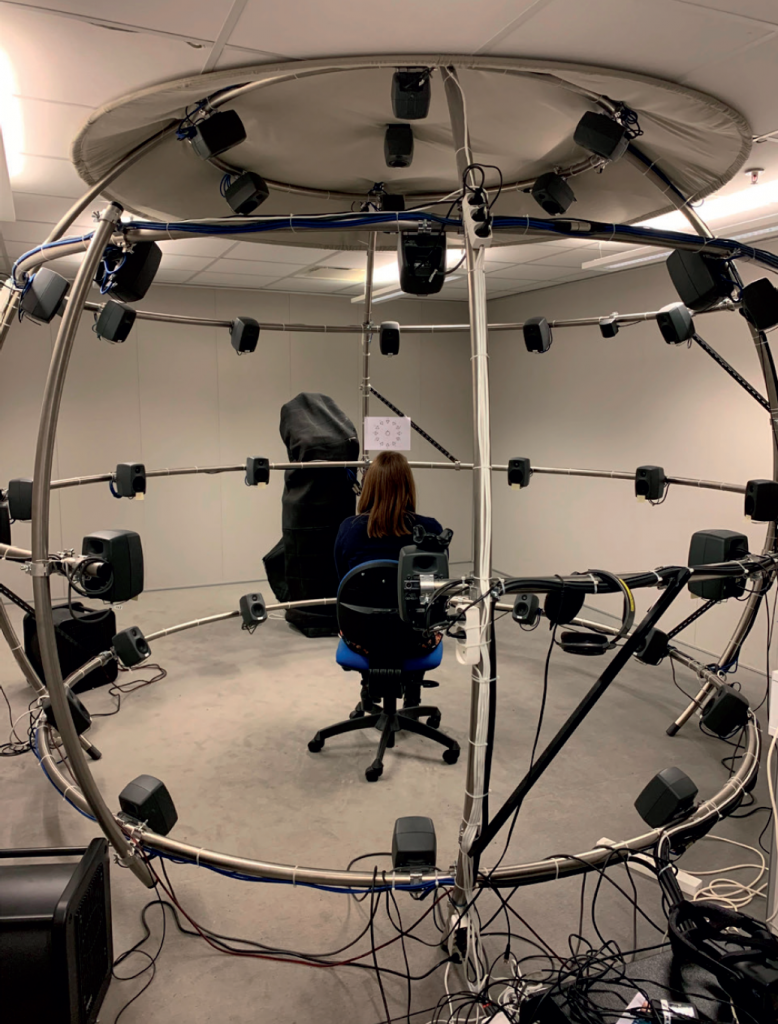
Results
The listeners with normal hearing showed a strong preference for M&RIE over omnidirectional mode and for M&RIE over Spatial Sense in all three listening scenarios: Cafeteria with talker, Traffic and Train Station. Therefore, the results have been merged. The results can be seen in Figure 3.
Binomial statistical tests were performed to determine whether the results were statistically significant. M&RIE was preferred significantly over omnidirectional (P<0.001) in eighty-seven percent of the trials by the listeners with normal hearing. M&RIE was preferred significantly over Spatial Sense (p<0.05) in 70% of the trials by the listeners with normal hearing.
The reasons reported by the normal-hearing listeners for preferring M&RIE were “Best feeling of noise reduction and best with speech”, “Clear, without too much sharpness”, “Speech is clearer in the cafeteria sound scenario”, “Less background noise” and “Best spatial perception, good speech intelligibility and sound quality”.
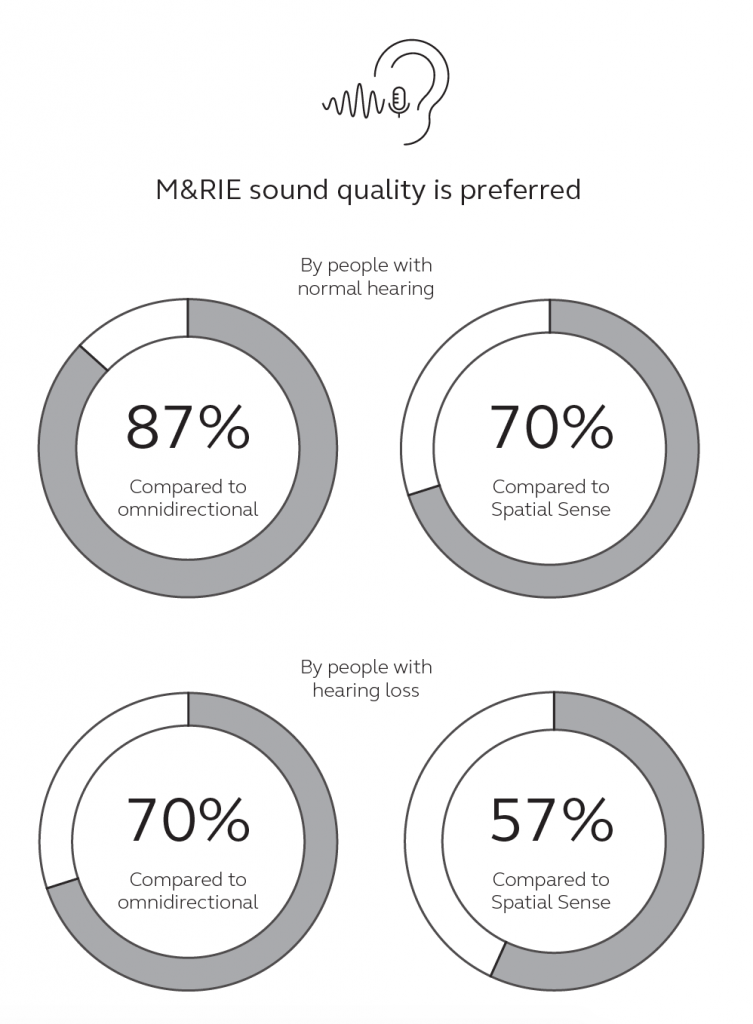
The listeners with hearing loss, like the listeners with normal hearing, showed a preference for M&RIE over omni- directional and for M&RIE over Spatial Sense in all three listening scenarios, and the results are therefore merged and shown in Figure 3. Binomial statistical tests were per- formed to determine whether the results were statistically significant. The listeners with hearing impairment preferred M&RIE over omnidirectional in 70% of the trials. M&RIE was preferred significantly over omnidirectional (p<0.05). The listeners with hearing impairment preferred M&RIE over Spatial Sense in 57% of the trials. This preference was not significant (p=0.58).
Half of the listeners with hearing loss reported that the differences between the programs they compared were small. Reasons given for preferring M&RIE were: “Speech is more distinct and background noise less distinct”, “Least disturbing sounds”, “Reduced listening effort, more comfortable and sometimes more intelligible” and “Less noise and better localisaton”.
Discussion
Most of us know what good sound quality sounds like when we hear it, but it can be difficult to describe. Hear- ing aid sound quality may be even more challenging to describe as hearing aid processing strategies significantly change the incoming sounds as they aim to compensate for lost auditory function. Therefore, sound quality for the hearing aid user necessarily includes how amplified sounds fit within the user’s range of hearing, whether sounds are distorted, and the degree to which undesired sounds such as background noises, acoustic feedback, or signal processing artifacts are heard and found annoying7. However, sound quality is more than this.
Sound quality preference is likely to be influenced by audibility, speech recognition and the ability to localize and segregate sounds. The reasons reported by listeners for preferring M&RIE in this test support that these factors influenced their preferences. From a theoretical perspective, this makes sense. A microphone placed in the ear relative to above the ear can improve localisaton, which can improve the ability to segregate sounds, thereby facilitating speech understanding.
Microphone placement within the pinna has been documented to provide better speech recognition in noise in research since the introduction of ITE hearing aids in the late 70s11-13. The ability to localize sound sources14 has also been shown to improve with microphone placement with- in the pinna as opposed to BTE microphone placement. The ability to perceive sounds in space, including their direction and distance, has been shown to decrease when listening through hearing aids with unnatural microphone placement above and behind the ear15.
The sound quality preference for M&RIE is likely to also be influenced by the positive effects of listening to sounds that are familiar and recognizable. In the condition with M&RIE, the participants were listening to the sound as shaped by their individually unique pinna, head and torso. This should make them familiar and recognizable and contributes to a sense of transparency and naturalness.
While the results strongly support that this is true for the normal-hearing listeners, the picture is more complicated for the listeners with hearing loss. Those with no hearing aid experience have become accustomed to reduced audibility of high frequency spectral cues. Those wearing RIE hearing aids are accustomed to listening via microphones located above and behind the pinna in their RIE hearing aids, and they may still have reduced audibility of high frequency information. Effects of acclimatization on sound quality preference among listeners with hearing loss is a relevant topic for further investigation.
The sound quality preference for M&RIE over omnidirectional is larger than the preference for M&RIE over Spatial Sense and this applies for both the listeners with normal hearing and the listeners with hearing loss. This finding is expected as Spatial Sense includes 2-microphone pinna compensation, which aims at compensating for the disadvantageous microphone location above and behind the ear. While it has positive effects, it is not individualized and does not account for sound coming from anywhere in space. However, it may still be acceptable to some listeners, as supported by our findings. We speculate that the filtering provided by their own anatomy in these cases may be quite similar to averages.
EXPERIMENT 2: LOCALISATON
Methods
Participants
The same normal-hearing listeners from Experiment 1 also participated in Experiment 2. The group with hearing loss included nine listeners from Experiment 1 and one person who had not been a listener in Experiment 1. Age and hearing loss characteristics for the group were unchanged. The median years of experience with amplification was 3 years (1st quartile: 1 and 3rd quartile: 5 years).
Hearing aids and fitting
ReSound ONE RIE hearing aids and premium level RIE hearing aids from four other hearing aid brands were used for the localisaton experiment. The test hearing aids were fitted bilaterally with closed double domes appropriate to the listener’s ear canal size and geometry to provide amplification across the frequency bandwidth of each device.
All test hearing aids were fitted with 10 dB of flat, linear gain for the normal-hearing listeners. For the listeners with hearing loss, the ReSound ONE hearing aids were fitted with prescribed gain using the ReSound proprietary Audiogram+ fitting rationale. The output of the hearing aids from the other brands was matched to the output of the ReSound ONE hearing aids in a 2cc coupler to avoid differences in audibility that could influence the localisaton results. Feedback suppression calibrations were conducted in all listeners’ ears as per each manufacturer’s guidance.
The ReSound ONE hearing aids were fitted with omnidirectional processing in one program, Spatial Sense in another program and M&RIE in a third program. The RIE hearing aids from the other brands were fitted with their default program including pinna compensation algorithms and feedback cancellation features. Other advanced features were turned off for all hearing aids.
Test conditions, methodology, setup, and target signal
The localisaton experiment included the 8 conditions listed in Table 2. The listeners did not know which condition they were listening to during the test. The testing order of the conditions was counterbalanced across test participants.

The localisaton test was conducted in the same lab described in Experiment 1. The listeners were seated in the center of a 12-loudspeaker array separated by 30⁰ as illustrated in Figure 4. It was ensured that the listeners’ ears were approximately on the same horizontal plane as the center of the loudspeakers. The listeners were encouraged to keep their head stationary throughout the test.

A 250 ms white noise target signal at 65 dB SPL was used for the localisaton experiment. The target signal was presented randomly from the speakers for each listener according to a Latin square design. Each angle was tested 5 times, resulting in a total of 60 signal presentations per test condition. The listener’s task was to identify the speaker where the signal originated by naming the speaker number with the help of a printed clock illustration. The listeners performed a training round prior to the actual test to familiarize themselves with the test. The training round was completed unaided with the stimulus level set to approximately 10 dB above the listener’s worst-ear threshold at 2 kHz to ensure audibility.
Results
Statistical comparisons were performed between M&RIE and the other seven test conditions. The Tukey Honest Significant Difference statistical criterion was used for the comparisons. The average localisaton error and front- back error were calculated for each test condition.
Average localisaton error is the average difference, in degrees, of the listeners’ responses compared to the actual locations of the stimuli. Front-back error is calculated as the percentage of times, out of all trials, that the listeners reported hearing the stimulus coming from in front of them when it came from behind them and vice versa.
Overall localisaton
Average overall localisaton error for the two groups of participants is shown in Figure 5. The results from the other hearing aid brands did not differ significantly from each other and are grouped together.
The pattern of results is the same for both groups of listeners with best performance in the unaided condition and worst performance in the omnidirectional with front RIE device microphone condition. Next best performance is shown with M&RIE followed by Spatial Sense and other brands. Both groups localized better in the unaided condition than in any other condition. The listeners with normal hearing showed better performance in all conditions than the listeners with hearing loss.
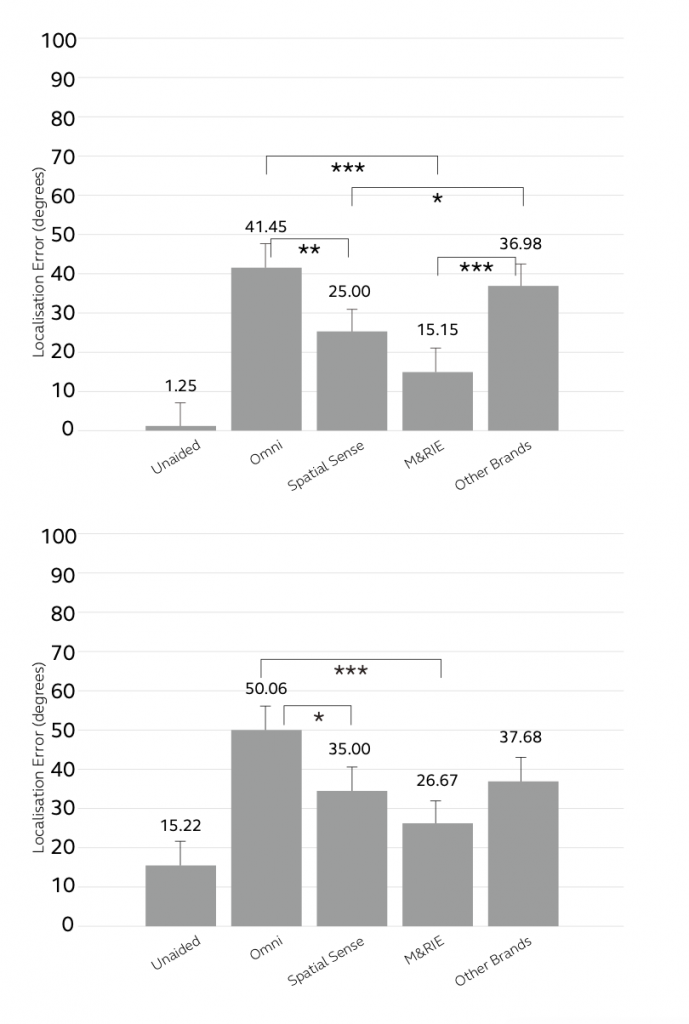
Front-back localisaton
As observed with overall localisaton error, the pattern of results is the same for the two groups. On average, both groups made the fewest front-back localisaton errors unaided. Interestingly, the differences in errors compared to unaided was significantly better than all other conditions except M&RIE. The group of listeners with hearing loss performed poorer overall than the listeners with normal hearing.
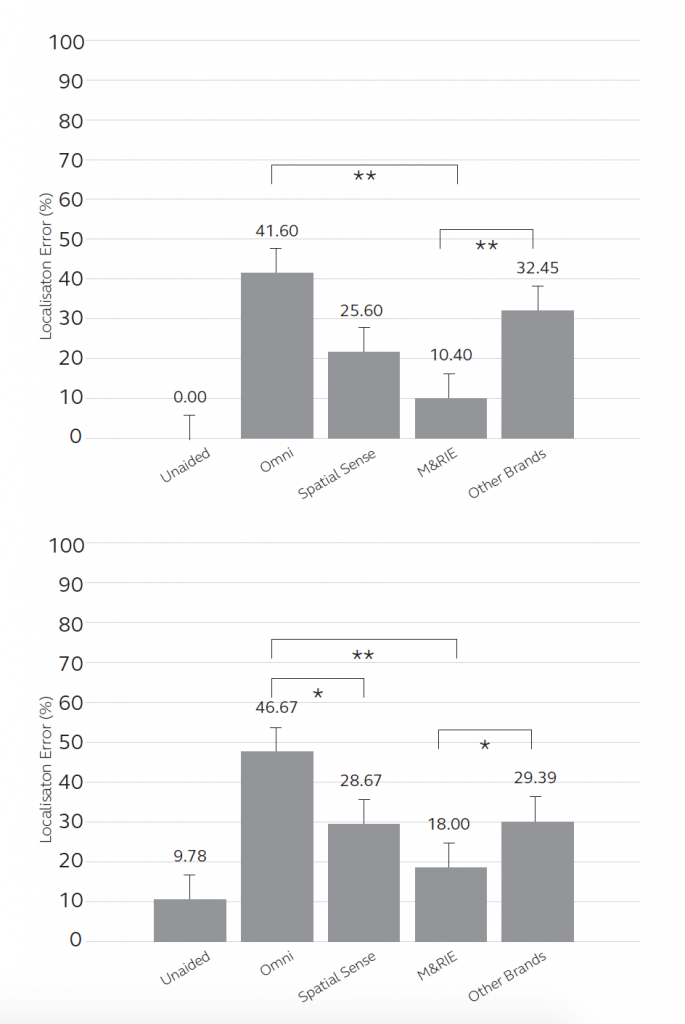
Discussion
It is clear from these results that omnidirectional microphones placed above and behind the ear compromise localisaton abilities. A microphone placed above and behind the ear removes the influence of the hearing aid user’s pinnae, thereby removing valuable information that would otherwise aid in localisaton. As can be seen in the unaided performance, listeners had little trouble localizing when their personal pinnae cues were available. For the normal-hearing listeners and those with hearing loss but no hearing aid experience, these are the same cues to which they listen every day. For those with hearing loss who wear RIE hearing aids, these results suggest that acclimatization to microphone placement above the ear does not mean users have “forgotten” how to make use of natural pinna cues provided by the open ear.
It is also clear that M&RIE preserves valuable information that aids in localisaton. The M&RIE condition was the next best for both groups of listeners. This result also supports that acclimatization to an unnatural microphone location does not necessarily preclude benefit from natural microphone location inside the ear canal. Ideal candidates for this solution will include both inexperienced and experienced hearing aid users. Candidacy will be determined by usable gain, not whether there is potential benefit of the in-ear microphone location.
Finally, Spatial Sense, which implements the directionality of an average pinna, head and torso allowed listeners to localize better than with omnidirectional microphones, which corresponds to earlier findings1,3. In addition, sound quality was judged equally good as M&RIE by the listeners with hearing loss nearly half of the time. For users who cannot be fit appropriately with M&RIE, these results confirm that Spatial Sense continues to offer a much-improved solution compared to omnidirectionality.
A closer look at the results for individual listeners (not shown) revealed that some listeners performed better with Spatial Sense than omnidirectional while others did not. Listeners who benefited from Spatial Sense may be those where the spectral filtering of their unique anatomy resembles the averages used in the Spatial Sense feature. It should be noted that none of the listeners showed poorer performance with Spatial Sense than omnidirectionality. The same is true for M&RIE compared to omnidirectional. None of the listeners showed poorer performance with M&RIE, with the vast majority performing better.
Overall, results from these experiments reinforced earlier results obtained with ReSound ONE and M&RIE during product development. People fit with ReSound ONE and M&RIE will have sound delivered uniquely to them, allowing them to hear like no other.
Summary
ReSound ONE with M&RIE combines the advantages of the RIE style with the benefits of collecting sound in the ear canals of the user. The potential benefits include the most natural sound quality with ability to separate sound sources and judge their depth and distance. Two experiments were carried out with groups of listeners that had normal hearing and hearing loss to validate these benefits. In both experiments, the pattern of results was the same for both groups, but results were more pronounced among those with normal hearing. Sound quality with M&RIE was preferred by both groups over omnidirectionality with the onboard microphone behind-the-ear in the RIE device. A weaker preference was demonstrated over the proprietary pinna compensation feature using the two onboard microphones of the RIE. Localisaton performance with M&RIE was similar to unaided, and better than omnidirectionality with microphone behind-the-ear location or the proprietary pinna compensation features of various hearing aid brands.
References
- Jespersen, C. Spatial hearing and severe hearing impairment. Zeitschrift für Audiologie. 2017; 56(2):66- 68.
- Groth, J. An innovative RIE with microphone in the ear lets users “hear with their own ears”. ReSound white paper. 2020.
- Groth, J. Binaural Directionality and Spatial Sense. ReSound white paper. 2015.
- Clark, JG. Uses and abuses of hearing loss classification. ASHA. 1981; 23:493-500.
- Groth, J. The evolution of the ReSound binaural hearing strategy: All Access Directionality and Ultra Focus. ReSound white paper. 2020.
- Legarth SV, Simonsen CS, Dyrlund O, Bramsloev L, Jespersen C. Establishing and qualifying a hearing impaired expert listening panel. Poster presentation at ICHON. 2012, Lake Tahoe.
- Jespersen, CT. Independent Study Identifies a Method for Evaluating Hearing Instrument Sound Quality. Hearing Review. 2014; 21(03):36-40.
- Darwin C J, Turvey MT, & Crowder RG. An auditory analogue of the sperling partial report procedure: Evidence for brief auditory storage. Cognitive Psychology. 1972; 3(2):255–267.
- Radvansky, GA. Human memory. Boston: Pearson/Allyn And Bacon: 2006
- Thaut, MH. Musical echoic memory training (MEM). In M. H. Thaut & V. Hoemberg (Eds.), Handbook of neurologic music therapy. Oxford University Press; 2014. p 311-313
- Risberg, DM, Cox, RM. Comparison of In-The-Ear and Over-The-Ear hearing aid fittings. Journal of Speech and Hearing Disorders. 1986 51(4):362-9.
- Festen JM, Plomp R. Speech-reception threshold in noise with one and two hearing aids. Journal of the Acoustical Society of America. 1986; 79(2):465–471.
- Pumford JM, Seewald RC, Scollie SD, Jenstad LM. Speech recognition with In-The-Ear and Behind-The-Ear dual-microphone hearing instruments. Journal of the American Academy of Audiology. 2000 Jan 1;11(1):23-35.
- Westerman S, Topholm J. Comparing BTEs and ITEs for localizing speech. Hearing Instruments. 1985; 36(2):20-24.
- Cubick J, Buchholz JM, Best V, Lavandier M, Dau T. Listening through hearing aids affects spatial perception and speech intelligibility in normal-hearing listeners. The Journal of the Acoustical Society of America. 2018 Nov 20;144(5):2896-905.


